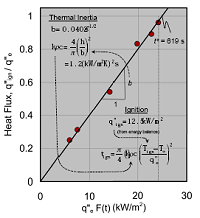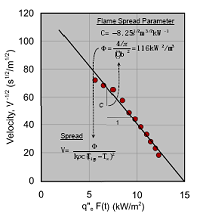Overview
 In 1985 the Department of Transportation (DOT) and Federal Aviation Administration (FAA) performed a study to establish a bench-scale test method to determine the ignition and flame spread properties of materials. The ASTM E1321 test standard was the result. The Lateral Ignition and Flame Spread Test (LIFT) test is used to determine effective material properties, namely kρc and Φ. These properties are useful for relative comparison of materials and for modeling ignition and flame spread behavior. ASTM E1321 is not currently used for regulation or fire rating purposes.
In 1985 the Department of Transportation (DOT) and Federal Aviation Administration (FAA) performed a study to establish a bench-scale test method to determine the ignition and flame spread properties of materials. The ASTM E1321 test standard was the result. The Lateral Ignition and Flame Spread Test (LIFT) test is used to determine effective material properties, namely kρc and Φ. These properties are useful for relative comparison of materials and for modeling ignition and flame spread behavior. ASTM E1321 is not currently used for regulation or fire rating purposes.
Setup
Lateral Ignition and Flame Spread Test (LIFT) configuration. For the flame spread tests, a radiant panel is used to establish a heat flux distribution along an 800 mm long test specimen. The flame spread velocity is measured as a function of incident heat flux along the specimen. The flame spread parameter, Φ, can be determined from the set of measured velocities.
Analysis
 |
 |
|
Ignition data for 3.175 mm thick hardboard(150 mm square). The thermal inertia, kρc,determined from the slope of the ignition curve, b, describes the time response of a material to heating and subsequent ignition. |
The flame spread parameter, Φ, is determined from the slope of the spread curve, C. The flame spread velocity depends on Φ and kρc. |
Top